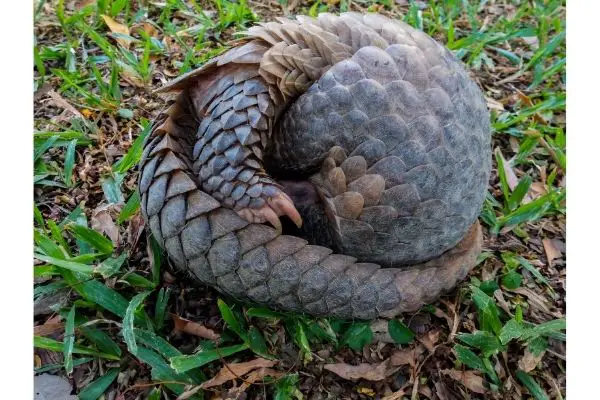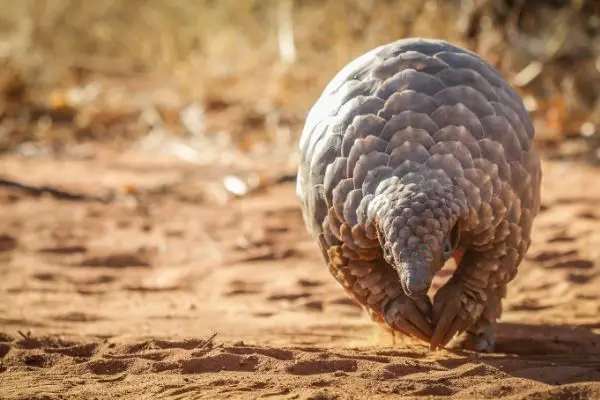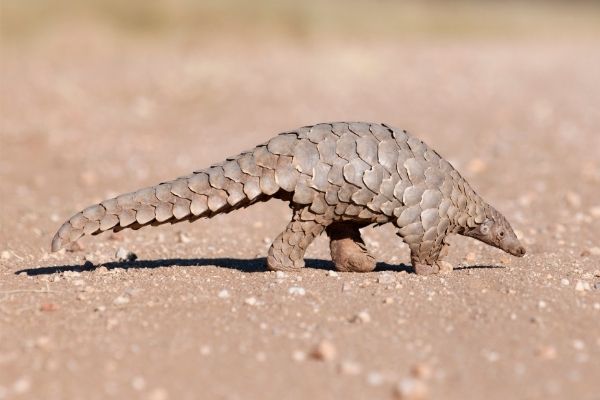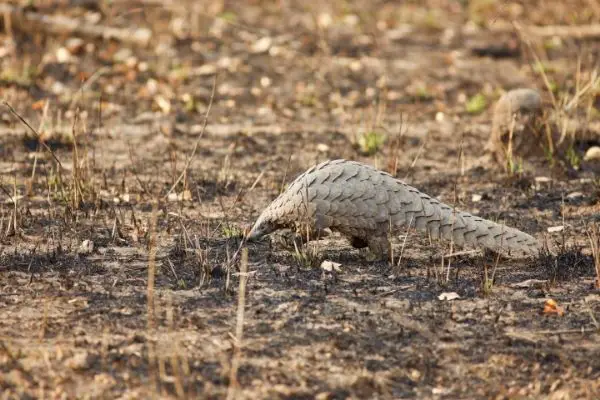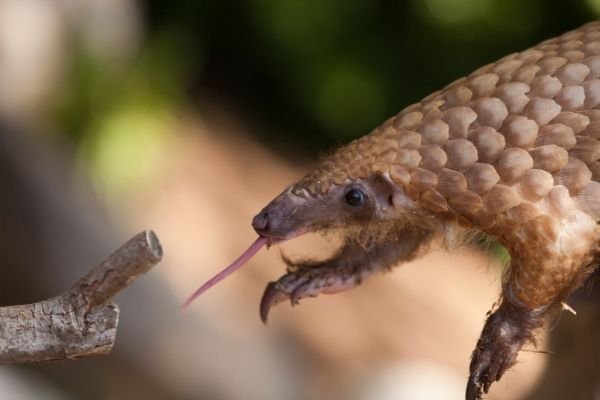Pangolin is well-known for the hard scales on its body, which protect it against predators. They look like reptiles but they are mammals. We have listed down complete Pangolin Facts for Kids that will help you in learning all about Pangolins. You are going to learn about its scientific name & classification, evolution, appearance, physical features, physical abilities, diet, habitat, lifespan, reproduction, babies, behavior, adaptations, food chain, ecological role, endangerment, population, predators, and many other interesting facts about Pangolins.
Pangolin Facts For Kids
Pangolins are the only known mammals to have scales on the body. They are the members of the family Manidae and order Pholidota. They are also known as scaly anteaters because of their diet and the scales on their body. The closest relatives of pangolins are carnivores (cats, dogs, and bears).
There are eight living species of pangolins. Four were found in Asia and the other four were found in Africa. Most species of pangolins are ground-dwelling while some are tree-dwelling. Pangolins are insectivores and eat ants and termites as their primary diet. The most distinguishing feature of pangolins is they roll up into a ball when threatened.
Pangolins are among the most smuggled animals in the world. Their meat is eaten as a delicacy in some Asian countries while their scales are used in traditional Chinese medicines.
What Is A Pangolin
A pangolin is any member of the family Manidae. Pangolins are also known as scaly anteaters. They belong to the order Pholidota. There are three genera in the family Manidae; Manis, Phatanigus, Smutsia. They are mammals and are found in Asia and sub-Saharan Africa. The most distinguishing feature of pangolins is their skin is covered with large protective scales made up of keratin.
Three species of pangolins are critically endangered, three are endangered, and two are Vulnerable on the IUCN Red List.
Scientific Name Of Pangolin
The following are the scientific names of all the pangolin species:
- Manis pentadactyla
- Manis culionensis
- Manis javanica
- Manis crassicaudata
- Phataginus tricuspis
- Phataginus tetradactyla
- Smutsia temminckii
- Smutsia gigantea
Scientific Classification Of Pangolin
The following is the scientific classification or taxonomy of pangolins:
- Kingdom: Animalia
- Phylum: Chordata
- Sub-phylum: Vertebrata
- Class: Mammalia
- Clade: Ferae
- Clade: Pholidotamorpha
- Order: Pholidota
- Family: Manidae
- Genera: Manis, Phatanigus, Smutsia
- Species:
- Manis pentadactyla
- Manis culionensis
- Manis javanica
- Manis crassicaudata
- Phataginus tricuspis
- Phataginus tetradactyla
- Smutsia temminckii
- Smutsia gigantea
How Many Species of Pangolins are there – Pangolin Species
There are eight species of pangolins. The following is a brief description of each species:
Philippine pangolin or Palawan pangolin (Manis culionensis)
This species is native to the Palawan province of the Philippines. It is found in primary and secondary forests. It is heavily hunted for scales and meat, due to which its survival is at risk. The species is Critically Endangered on the IUCN Red List.
Chinese pangolin (Manis pentadactyla)
This species is indigenous to the northern regions of the Indian subcontinent, northern regions of Southeast Asia, and southern China. It is listed as Critically Endangered by the IUCN Red List. Poaching is a major threat to the survival of this species.
Sunda pangolin, or Mlayan or Javan pangolin (Manis javanica)
This species is found all over Southeast Asia. This species is also Critically Endangered on the IUCN Red List.
Indian pangolin or thick-tailed pangolin (Manis crassicaudata)
This species is indigenous to the Indian subcontinent. It is not common in its habitat range and is threatened by illegal hunting. It is Endangered on the IUCN Red List.
Tree pangolin, three-cusped, or white-bellied pangolin (Phataginus tricuspis)
This species is indigenous to equatorial Africa and is the most common among the African forest pangolins. The species is Endangered on the IUCN Red List.
Long-tailed pangolin or African black-bellied pangolin or ipi (Phataginus tetradactyla)
This species is indigenous to parts of western and central Africa. It is Vulnerable on the IUCN Red List.
Giant pangolin (Smutsia gigantea)
This species is indigenous to parts of western and central Africa. It is Vulnerable on the IUCN Red List.
Ground pangolin, or Cape pangolin, or Temminck’s pangolin
It is the only species found in southern and eastern Africa. The species is Vulnerable on the IUCN Red List.
Pangolin Evolution
Genetic evidence suggests that carnivores are the closest living relatives of pangolins, and together form a clade termed as Ostentoria or Farae. It is estimated that pangolins split from the carnivore about 79 to 87 million years ago. The divergence of Asian and African pangolins is thought to have occurred around 38 to 47 million years ago.
What Does A Pangolin Look Like
Appearance
In appearance, pangolins look like reptiles because their body is covered in scales. When they curl up into a ball, they look like armadillos. They have a medium-sized body (about the size of a large house cat) and a long prehensile tail, which support movement and balance. They are sexually dimorphic and male individuals are larger than females. Pangolins have a small conical head with an elongated snout and small eyes covered with thick lids.
They have long tongues, which resemble a worm. Pangolins do not have any teeth. Their bodies are throughout covered with plate-like scales except for the underbellies and sides of their face. The scales are made up of keratin, which are proteins that also make our nails. Their undersides are covered with soft hairs. Pangolins have short legs and five-toed feet, which are equipped with sharp claws.
Color
The scales that cover the body of pangolins range in color from light to yellowish-brown or from olive to dark brown. The color of their scales sometimes resembles their surroundings. The color of their undersides is light. The Youngs have pink or pale brown color at birth.
Physical Features of Pangolin
The physical features of all the living pangolin species are:
Philippine pangolin or Palawan pangolin
- Weight: 0.1 to 34.93 kg (2 to 77 lbs)
- Body Length: 12 to 35 inches
- Tail Length: 10 to 35 inches
Chinese pangolin
- Weight: 2 to 7 kg (4.4 to 15.4 lbs)
- Body Length: 16 to 23 inches
- Tail Length: 9.8 to 15 inches
Sunda pangolin, or Malayan or Javan pangolin
- Weight: Up to 10 kg (22 lbs)
- Body Length: 15.7 to 25.5 inches
- Tail Length: 13.7 to 22 inches
Indian pangolin or thick-tailed pangolin
- Weight: 10 to 16 kg (4.4 to 15.4 lbs)
- Body Length: 20 to 29 inches
- Tail Length: 13 to 19 inches
Tree pangolin, three-cusped, or white-bellied pangolin
- Weight: 1.5 kg (3.3 lbs)
- Body Length: 13 to 17 inches
- Tail Length: 19 to 24 inches
Long-tailed pangolin or African black-bellied pangolin or ipi
- Weight: 2.0. to 2.5 kg (4.4 to 35.5 lbs)
- Body Length: 12 to 16 inches
- Tail Length: 24 to 28 inches
Giant pangolin
- Weight: 33 kg (72.6 lbs)
- Body Length: 29.5 to 31 inches
- Tail Length: 19.6 to 25.5 inches
Ground pangolin, or Cape pangolin, or Temminck’s pangolin
- Weight: 5 to 27 kg (10 to 60 lbs)
- Body Length: 11.8 to 35.4 inches
- Tail Length: 10 to 28 inches
Physical Abilities
How Fast is a Pangolin – Pangolin Speed
Pangolins use all four limbs when moving slowly in relaxed conditions. However, they stand up on their hind feet to attain speed while using their long prehensile tail for support. Their top running speed is approximately 5 km per hour (3 mph).
Climb
Some pangolin species are arboreal (live in trees) and excellent climbers. They use their claws and prehensile tail to climb.
Swim
Pangolins can swim. Giant pangolin tends to live near water in moist habitats.
What Do Pangolins Eat – Pangolin’s Diet
In the Wild
Pangolins are insectivorous and consume insects. They primarily eat various species of ants and termites. They also eat many other invertebrates, such as flies, worms, bees, insect larvae, crickets, and earthworms. Pangolins consume a somewhat specialized diet and tend to eat only one or two species of insects, even when a large variety of insect species are available to them.
To find and eat food, they highly depend on their sense of smell. As they do not have teeth, so they directly swallow unchewable food. However, they also ingest small stones in their food, which accumulate in the gizzard and help in the grinding of food. Their gizzard also has spines that help in the grinding and digestion of food.
In Captivity
The maintenance of pangolins in captivity is extremely difficult because they consume a somewhat specialized diet. They often reject to consume new and foreign insects or become ill when fed with unfamiliar food.
Several artificial captive diets have been developed for captive pangolins according to the food composition they naturally eat. The ingredients of the captive diet include eggs, milk, milk powder, meat (minced beef, fish, and horse meat), canned feline diet, commercial chows, insects, multivitamins, carrots, psyllium seed, orchid leaves, and yeast, etc.
List Of Food Items
The following are the major food items of the pangolins:
- Ants
- Termites
- Flies
- Bees
- Insects
- Insect larvae
- Earthworms
- Crickets
How Much Pangolins Eat Per Day
A pangolin eats 140 to 200 grams of insects per day. An estimate indicates that it can eat up to 20,000 ants and termites per day.
What Do Baby Pangolins Eat
Baby pangolins are fed exclusively on the mother milk for one month. At the age of one month, they also start consuming ants and termites along with the mother milk.
Where Do Pangolins live – Pangolin’s Habitat
Pangolin’s Natural Habitat
Philippine Pangolin
Philippine pangolins inhabit low land forests, agriculture areas, and grasslands. Little is known about the favorite habitat of this species because of its nocturnal behavior, solitary nature, and limited research on the
Chinese Pangolin
Chinese pangolins are found in deciduous, bamboo, limestone, and subtropical forests. In central Nepal, these regions are on a series of low hills, where numerous termite mounds are found. They also inhabit grasslands and agricultural fields. They have been recorded at the altitude of 3,000 meters (9,800 feet), above sea level. Chinese pangolin is a burrowing species and digs up to 8 feet deep burrows. Once inside the burrow, it closes the entrance. It sometimes also inhabits the burrows of other animals.
Sunda Pangolin
Sunda pangolins are found in a variety of habitats including primary and secondary forests, open grasslands, and regions with thick bushes. They are also sometimes observed in plantations (rubber or palm oil) and gardens. Sunda pangolins are also terrestrial and dig burrows where they live. They also inhabit burrows of other animals or other pangolins. They are also good climbers and spend a large time of their life in trees resting or foraging.
Indian Pangolin
Indian pangolins inhabit a variety of habitats including desert areas, barren hilly regions, secondary forests, subtropical thorn forests, grasslands, and salty regions. In Sri Lanka and Nilgiri mountains, they were observed at altitudes of 1,100 and 2,300 meters, respectively. They prefer to live in regions with semi-sandy soil, which is soft and suitable for digging burrows.
Tree Pangolin
Tree pangolins inhabit primary and secondary lowland tropical moist forests and forest-savannah mosaics. It is semi-arboreal and found in trees and on the ground.
Long-tailed Pangolin
Long-tailed pangolins inhabit moist, tropical riverine and swamp forests. They are also observed in bushes and agricultural regions of former lowland rainforests. They are strictly arboreal and spend most of their time in trees. They inhabit the canopy region of the forest.
Giant Pangolin
Giant pangolins mainly inhabit grasslands, rainforests, and forests. They prefer to live in regions with large populations of termites and near water. They take shelter in burrows or under piles of debris. Their burrows may be several meters deep, which they either dig themselves or use the abandoned burrows of other animals.
Ground Pangolin
Ground pangolins prefer to live at lower altitudes in savannah woodland with moderate amounts of scrub.
Pangolin’s Biome
Pangolins live in various biomes including forests, savannah or grasslands, scrub forests, and deserts.
Pangolin’s Range
Philippine Pangolin
The range of Philippine pangolins is limited to four islands of the Philippines, which are: Palawan, Busuanga, Culion, and Calauit. They are also introduced to Apulit island.
Chinese Pangolin
The habitat range of Chinese pangolins covers southern Nepal, northern regions of India, Bhutan, Bangladesh, Myanmar, northern Indochina, southern regions of China, and most parts of Taiwan.
Sunda Pangolin
The habitat range of Sunda pangolins is throughout Southeast Asia. Their habitat range covers Myanmar, Thailand, Cambodia, Vietnam, Laos, Malaysia, Singapore, and the islands of Java, Borneo, Sumatra, and the Lesser Sunda Islands.
Indian Pangolin
The habitat range of Indian pangolins is across Southern Asia. It covers the eastern parts of the Punjab and Sindh provinces of Pakistan, almost all India and Bangladesh, and extends to northern Burma and the southern parts of the Yunnan province in China. In the north and south, their habitat range extends as far as Nepal and Sri Lanka.
Tree Pangolin
The habitat range of tree pangolins is from Guinea to Sierra Leone and covers much of the Western to Central Africa and extends as far east to south-western Kenya and northwestern Tanzania. Towards the south, it extends to northwestern Zambia and northern Angola. They are also found on the island of Bioko.
Long-tailed Pangolin
The habitat range of long-tailed pangolins is located in parts of western and Central Africa.
Giant Pangolin
The habitat range of giant pangolins is the westerns to central regions of Sub-Saharan Africa.
Ground Pangolin
The habitat range of ground pangolins is located in southern and eastern Africa. It is the only pangolin species found there.
Countries List
The following are the major countries where pangolins were found:
- China
- Taiwan
- Thailand
- Cambodia
- Laos
- Myanmar
- Guinea
- India
- Pakistan
- Malaysia
- Singapore
- Indonesia
- Uganda
- Tanzania
- Kenya
- Democratic Republic of Congo
- Rwanda
- Gabon
- Nigeria
- The central African Republic
- Ghana
- Liberia
- Senegal
- Gambia
Pangolin’s Lifespan
The lifespan of all the pangolin species in the wild is unknown. Pangolins do not do well in captivity and only a few individuals survived in zoos. The lifespan of Philippine, Sunda, Indian, and Long-tailed pangolin species in captivity is about 20 years. The captive lifespan of Tree pangolin species is about 10 years, of the giant pangolin species is about 4 years, and of the ground and Chinese pangolin species is unknown.
Pangolin’s Life Cycle
The life cycle of a pangolin starts when it is born after a gestation period of about 70 to 140 days. The baby is fed by the mother for up to three months. At the age of 2 years, the baby becomes sexually mature and independent. It then searches for a mate to start its own family. The lifespan of pangolins in the wild is unknown. They live for 4 to 20 years in captivity depending on the species.
Pangolin Reproduction
Pangolins are solitary creatures and meet only for mating.
There is no specific mating season for pangolins, however, they usually mate once a year in summer or autumn. To find a mate, a male does not seek out a female but rather marks its location with feces or urine and the female has to find him. In case of competition over a female, the males will fight with each other using their tails as a weapon to get the opportunity of mating.
The gestation period varies from species to species, however, it roughly ranges from 70 to 140 days. African pangolin species usually give birth one baby at a time, while the Asian species give birth to one to three babies. The mothers nurse the babies for three months.
Pangolin’s Baby Facts
- At birth, a pangolin baby has an average head-to-tail length of up to 6 inches, while it weighs from 80 to 450 g.
- At birth, the baby has soft scales usually of white or pink color, which then hardens and darker after several days.
- In burrowing species, the baby spends its vulnerable period in the burrow where the mother stays with him, feeds him with her milk, and wraps her body around him if she feels in danger. The baby stays in the burrow for the first two to four weeks after birth.
- In other species, the baby clings to the tail of its mother when she moves about.
- At the age of one month, the baby leaves the burrow for the first time riding on the back of its mother. At this stage, the baby also starts eating ants and termites in addition to the mother’s milk.
- The baby is weaned at the age of three months.
- Pangolin babies stay with their mothers for about 2 years. After two years, they become sexually mature and the mothers abandon them.
Behavior Of Pangolin
Pangolins are solitary and stay alone. They meet only to mate. Most species are nocturnal and remain active during the night. They spend most of their daytime resting, curled up into a ball. The long-tailed pangolin also remains active during the daytime. Pangolins are also highly secretive, that is why it is so difficult for scientists to research them in the wild.
Some pangolins are ground-dwelling while some are arboreal. Ground-dwelling species dig underground burrows, which may be 3.5 meters (11 feet 6 inches) deep. They also sometimes use the abandoned burrows of other animals. Arboreal pangolins live in hollow trees. Some pangolin species bent their front claws under the footpads when walking. Some also show bipedal posture and walk a few steps with only on their hind limbs.
When pangolins feel threatened, they quickly curl up into a ball using their scales like armor to protect their undersides. They make hissing and puffing sounds and lash their sharp-edged tails to deter predators. Pangolins mark their territories with urine, feces, and secretions from a special gland near their anus. Scientists say that these smells probably publicize their sexual status and dominance and may also help the individual pangolins to recognize each other.
Pangolin Adaptations
The following are the major physical and physiological adaptations of the pangolins.
Physical Or Structural Adaptations
Protective Overlapping Scales
Pangolins have large, hardened, and sharp overlapping scales on their bodies. The scales provide them extra protection from predators and act as armor. When threatened, they curl up their body into a ball and tuck their face under their tail.
Color Of Scales
The scales on the body of pangolins have pale brown to olive to dark brown color that usually blends in with their surroundings. It provides them camouflage against predators, which is an important adaptation for their survival.
Sharp Claws
Pangolins have well-adapted sharp claws, especially on their front feet. They use it for climbing and for digging burrows where they live. They also use their sharp claws to dig into the mounds, ground, and vegetation to find termites and ants.
Long And Prehensile Tail
Pangolins have long and prehensile or semi-prehensile tails. Their tail sometimes exceeds the length of their body. The tail provides them balance during locomotion and helps in climbing. The arboreal species use their tail as an extra limb. When foraging for ants in the trees, they often hang with their tail and use their claws to strip away the tree bark and expose the prey. When threatened, they quickly curl into a ball and tuck their head inside their tail. They also use their tail as a weapon to deter predators.
Long Tongue
Pangolins have exceptionally long tongues. Large individuals can extend their tongues as much as 16 inches. They use their long tongue to probe inside the tunnels of insects to catch prey.
Physiological Adaptations
Sticky Saliva
The sticky saliva of pangolins is an important adaptation. It causes the prey to stick to their long tongue when they enter it inside the insect tunnel.
Having Spiny Gizzard
Pangolins have well-adapted gizzard (a part of their stomach) equipped with keratinous spines. As they do not have teeth and swallow unchewed food directly. So they also ingest small stones (known as gastroliths), which accumulate in their gizzard and help in the grinding of food. The spines then further help in the grinding and digestion of food.
Sharp Sense Of Smell
Pangolins have a well-developed sense of smell. They use their sense of smell to locate and find prey and mates.
Special Muscles In Ears And Nostrils
Pangolins have special muscles in their ears and nostrils, which keep them closed and do not allow the attacking insects to enter.
Scent Glands Near The Anus
Pangolins have scent glands located near their anus. The glands secret a noxious-smelling chemical, which they use to mark their territory and to attract mates.
Pangolins Food Chain
In the food chain of pangolin, the sun is the overall source of energy like most other food chains. Green plants and vegetations are the producers. They use solar energy and prepare their food themselves. Ants and termites are the primary consumers that consume diets of plant origin. Pangolin is the secondary consumer. It is a carnivore and eats ants and termites as a main part of its diet. The predators of pangolins, such as leopards, hyenas, and pythons, are the tertiary consumers.
Ecological Role Of Pangolins
Pangolins play an important role in their ecosystem. Their insatiable appetite for insects makes them fantastic natural pest controllers. It has been estimated that a pangolin consumes more than 70 million insects per year. They are also excellent tenders of soil, and they simply do these things as part of their daily foraging behavior.
Population Of Pangolins
The exact population of all the pangolin species is unknown. However, the population trend of all the species is decreasing.
Pangolins Endangerment
Reasons
The following are the major reasons for the endangerment of the pangolins:
1. Poaching or illegal hunting
Illegal hunting (poaching) is the major reason for the endangerment of pangolins. They are hunted for their meat and scales. Their meat is considered a delicacy in some countries of Asia. While their scales are used in traditional Chinese medicines to help many problems and diseases, ranging from difficulties in lactation to epilepsy and arthritis. The Philippine coast guards seized a boat in April 2013, which had 10,000 kg of pangolin meat. There were also thousands of frozen pangolins in 400 boxes.
The Asian species of pangolin were the main target of poachers for many years. However, now their number is depleted so the poachers are greatly turning to African species. In April 2019, a 14.2 tons shipment and another 14 tons shipment of pangolin scales coming from Nigeria were seized in Singapore in just a couple of weeks. It was estimated that these scales were obtained from about 72,000 pangolins.
2. Habitat Loss
Loss of habitat is another major reason for their endangerment. Deforestation and climate change destroy their natural habitat and make their survival difficult.
Conservation Status
The conservation status of all the pangolin species on The IUCN Red List is as follows:
- Philippine pangolin or Palawan pangolin: Critically Endangered
- Chinese pangolin: Critically Endangered
- Sunda pangolin, or Malayan or Javan pangolin: Critically Endangered
- Indian pangolin or thick-tailed pangolin: Endangered
- Tree pangolin, three-cusped, or white-bellied pangolin: Endangered
- Long-tailed pangolin or African black-bellied pangolin or ipi: Vulnerable
- Giant pangolin: Endangered
- Ground pangolin, or Cape pangolin, or Temminck’s pangolin: Vulnerable
Pangolins Predators
Leopards, hyenas, and pythons are the major natural predators of pangolins. Humans are the greatest predators of pangolins and hunt them excessively for their meat and scales.
Pangolins Fun Facts
- The origin of the word ‘pangolin’ is the Malaya word ‘penggulung’, which means ‘one who rolls up’. This name is given to the animal due to its ability to roll itself into a ball when it feels threatened.
- Pangolins are also known as scaly anteaters because of the scales on their body and their diet, which mainly consists of ants and termites.
- Pangolins are the only known mammals with scales covering their skin.
- The scales that cover the pangolin body are made up of keratin, the same material that makes our nails.
- The high demand for the meat and scales of pangolins make them the most trafficked animals in the world. It has been estimated that about one million pangolins have been smuggled from 2000 to 2013.
- Pangolins eat an extremely specialized diet. That is why it is very difficult to keep them in captivity.
- The tongue of pangolins may be longer than their body. Their tongue root is attached below the last set of ribs, not to the hyoid bone.
- It has been estimated that an adult pangolin eats more than 70 million insects per year.
- The tail of the African long-tailed pangolin has 46 to 47 vertebrae.
- In some Asian countries, the meat of pangolin is considered a delicacy. Their meat is sold at the price of about $200 per kilogram.
- The scales of pangolins are used in traditional Chinese medicines to help certain problems and diseases. However, there is no proven medicinal value of their scales.
FAQs:
Is a pangolin an armadillo?
No, a pangolin is not an armadillo. Pangolins can just make a rolling defense posture like armadillos.
Are pangolins related to armadillos?
No, pangolins are not related to armadillos. The closest relatives of pangolins are carnivores (cats, dogs, and bears).
Are Pangolins dangerous?
Pangolins are shy and not dangerous. They simply roll up into a ball if they feel threatened. However, they will use their scales as a weapon and will perform a cutting motion with it if an animal inserts its paw or snout between them.
Why is the pangolin the most trafficked animal?
Pangolins are the most trafficked animals because their meat is considered a delicacy in some Asian countries and their scales are in high demand, which is used in traditional Chinese medicines.
Pangolin and Covid-19
SARS-CoV-2 is the virus that caused the current pandemic of Covid-19. A hypothesis by the researchers of Guangzhou (China) said that SARS-CoV-2 originated in bats. Before infecting humans, the virus was circulating among pangolins. The illegal trade of pangolins in China was suggested as a vector for the transmission to humans. However, the comparison of the whole genome found that the Covid-19 viruses of humans and pangolins share only 92% of their RNA. Pangolins are considered as possible hosts of Covid-19, but it has yet to be proven.
Pangolin Vs Armadillo
| Pangolin | Armadillo |
| Belongs to order Pholidota | Belongs to order Cingulata |
| Has keratin scales on the body | Has bony armor shell on the body |
| Native to Asia and Africa | Native to Americas |
| Do not have teeth | Have teeth |
| Eat ants and termites | Eat grubs, insects, and other invertebrates |

